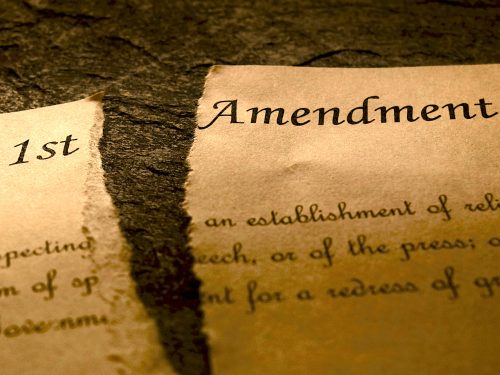Christian Nationalism and Bible Prophecy
By
Andy Im, Director, Religious Liberty
- November 16, 2023
Christian Nationalism and Bible Prophecy
A litmus test for identifying the end-time dragon-speaking beast of Revelation 13, mirroring the medieval beast, requires a professing Christian establishment closely aligned with and steering civil and political powers.
Recap of Revelation 13
There is perhaps no clearer, more explicit depiction of how the end-time narrative plays out than Revelation 13.[1] This is particularly true for Americans, though the scope will be worldwide.[2] The chapter begins with a description of the leopard-like beast, also referred to as the first beast, which Adventists believe represents the papacy. It is characterized by blasphemy and the persecution of God’s faithful, with the dragon (i.e., Satan) bearing responsibility as the primary culprit. The papacy reigned as a unified church-state power for 1,260 years, from AD 538 to 1798, when it received its “mortal wound” (Napolean Bonaparte ordered the abduction of Pope Pius VI).
The United States in Bible Prophecy
In verse 11, the focus pivots to Protestant America, represented by a beast with lamblike horns.[3] This nation is depicted as docile, even Christlike, but the façade gives way to its tyrannical features when it speaks like the dragon of the medieval period. The prophecy also indicates that in the future, the United States will mandate allegiance to papal authority by enforcing Sunday worship[4] (see verse 12).
Before that takes place, something resembling the papacy’s framework will be established in Protestant America,[5] enabling the authorization of Sunday enforcement (see verses 14, 15). To understand what that might be, one needs to grasp the composition of the papacy or medieval church because Scripture indicates that the end-time manifestation will be a copy or replica of the first.[6] Simply put, prior to its mortal wound, the papal system functioned as a unified church-state sovereignty, exercising control over the governing political powers, enabling the punishment and even execution of dissenters.
Union of Church and State in Bible Prophecy
In this nation, a corresponding equivalent will occur when Christian churches unite with and exert control over civil and political authorities to enforce the convictions of apostate Protestant churches.[7] In other words, sometime in the future, the United States will mutate into a united church-state government resembling the persecuting power of the medieval period. Protestant Christian churches and entities, pastors, and professing Christians will be the ones leading the charge alongside the civil and political powers towards Sunday enforcement.[8] When religious liberty is stripped from Seventh-day Adventists, it is because Protestant Christendom has made it so.
When this takes place, Protestant America will fully manifest itself as a dragon-speaking authority, leading to end-time persecution.
When the Protestant churches shall unite with the [state] to sustain a false religion … when the state shall use its power to enforce the decrees and sustain the institutions of the church,—then will Protestant America have formed an image to the Papacy, and there will be a national apostasy which will end only in national ruin.
Revelation 13:15 indicates that sometime after the transition into a united church-state power, Protestant America will “speak and cause” the death of those who refuse Sunday worship. The “speaking,” Ellen G. White suggested, signifies the actions of the legislative and judicial authorities,[9] implicating the role that Congress and the federal judicial system will play in the final crisis.
Christian Nationalism
While "Christian nationalism" wasn't a term used during Ellen G. White's time, her portrayal of what Christian activists were seeking to achieve through the arm of the government is an apt depiction. During her era, Christians were striving to establish:
the kingdom of Christ as an earthly and temporal dominion. They [desired] to make our Lord the ruler … in its courts and camps, its legislative halls … and market places. They [expected] Him to rule through legal enactments, enforced by human authority. Since Christ is not now here in person, they … [undertook] to act in His stead, to execute the laws of His kingdom.
Various definitions and perspectives of “Christian nationalism” are available,[10]encompassing elements such as history, race, culture, and so on. At the crux for Adventists, the term encapsulates flourishing thought trends of Americans to officially identify as a Christian nation and advocate, even legislate, Christian values and beliefs.[11]
“Christian nationalism” threatens religious liberty for Adventists because it implies a fusion of church and state, enabling Protestant-evangelical establishments to use civil and political powers to impose their beliefs on others. Prophecy indicates that these current emerging thought trends will become reality, leading to the eventual enforcement of Sunday worship and persecution as we approach the end of earth's history.
Conclusion
Revelation 13 unfolds a prophetic narrative featuring the papacy, symbolized by a leopard-like beast. The narrative then shifts to Protestant America, anticipating the emergence of a system reminiscent of the medieval church. In this scenario, a union between Protestant church institutions and civil and political authorities will lead to the enforcement of Sunday worship.

“Christian nationalism” presents a genuine threat to religious liberty because it assumes a merging of church and state powers, creating an avenue for civil and political forces to enforce specific religious beliefs on others. Despite the distressing unraveling of society’s moral fabric, our mission is to effect change by reaching people’s hearts with the gospel message, not by legislating tenets of faith.
Things are not always as they appear. We may be approaching a critical prophetic period where influential, even devout Christians and political leaders will lead many astray. The appearance of Christian attributes (i.e., lamblike), the implementation of Sunday Christian worship, the display of miraculous signs, including "fire [coming] down from heaven," and the shift towards a Christian nationalist state collectively point to a looming wave of deception orchestrated by Christians in positions of power and influence.
A political or civil entity separated from Christianity, or a Christian establishment detached from the state, doesn’t fully meet the criteria of the end-time persecuting power described in Revelation 13. A litmus test for identifying the end-time dragon-speaking beast of Revelation 13, mirroring the medieval beast, requires a professing Christian establishment closely aligned with and steering civil and political powers. This alliance will ultimately enforce its beliefs on others with the threat of penalty and death. The end-time entities and forces slated to play a role in the final crisis in America must broadly conform to this paradigm.
Religious powers, allied to heaven by profession and claiming to have the characteristics of a lamb, will show by their acts that they have the heart of a dragon, and that they are instigated and controlled by Satan. The time is coming when God’s people will feel the hand of persecution because they keep holy the seventh day.
Notes and Works Cited
[1] For a summary of Revelation 13 by Ellen G. White, see the chapter entitled, “God’s Law Immutable,” in The Great Controversy, pp. 439-450.
[2] The global nature of end time events as it relates to the papacy and world governments can be studied in greater detail in Revelation 17.
[3] The eschatological focal point at this juncture isn’t the wounded medieval power. Nevertheless, the papacy continues as a developing story because Scripture predicts its future reemergence.
[4] The testing crisis at the end of time involves worship of the first beast. Sunday worship is understood by Seventh-day Adventists to be an act of homage to the papacy because they are responsible for changing the day of worship, originally instituted by God Himself, from Saturday to Sunday. “Here the papal power openly sets itself above God” (see Ellen G. White, The Great Controversy, pp. 445–450).
[5] In verses 14–15, the land beast institutes an image—something resembling the first beast. To determine what that is, one needs to study the characteristics of the papacy itself.
[6] “But what is the ‘image to the beast’? and how is it to be formed? The image is made by the two-horned beast, and is an image to the first beast.… Then to learn what the image is like and how it is to be formed we must study the characteristics of the beast itself—the papacy” (The Great Controversy, p. 443).
[7] “The ‘image to the beast’ represents … apostate Protestantism which will be developed when the Protestant churches shall seek the aid of the civil power for the enforcement of their dogmas” (The Great Controversy, p. 445, emphasis added). A number of Adventist pioneers state similar conclusions, including A.T. Jones, James White, Uriah Smith, S.N. Haskell, and others.
[8] The United States and its governing authorities, the Protestant establishment and churches, clergy, and professing Christians are used interchangeably by Ellen G. White to describe actions taken under the auspices of the two-horned beast that culminates in religious tyranny (see, for example, The Great Controversy, p. 592; Seventh-day Adventist Bible Commentary, vol. 7, p. 975; and The Review and Herald, “An Address in Regard to the Sunday Movement,” December 24, 1889.
[9] See The Great Controversy, p. 442.
[10] A number of books and online content are available on the subject.
[11] An example of an advocate for Christian nationalism and the legislation of Christian beliefs is Stephen Wolfe in his book, The Case for Christian Nationalism.

